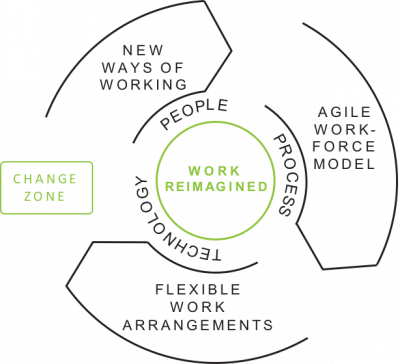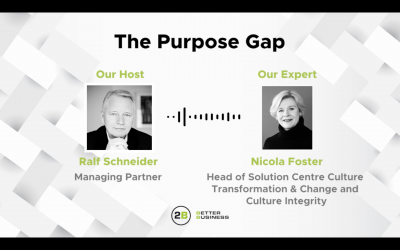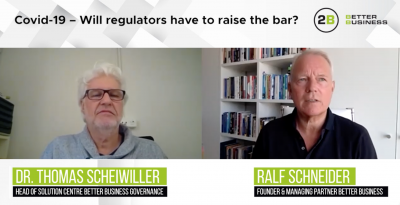The evolution of Next Generation Leadership
by Ralf Schneider
Head of Solution Centre - Leadership Brand.
The writing has been on the wall for a while.
Not everything will be different tomorrow, but powerful forces are at work re-defining the way we do business and transforming how we interact in our day-to-day lives, as customers, employees and members of communities.

New business models are being created at warp speed, canibalising existing ones. Already, they have been re-shaping the face of whole industries like Retail, Media, Tourism or Financial Services. Many others are about to follow.
The traditional way we work, how we perform our job and think about our future is being challenged. With traditional forms of employment under siege, the idea of a life-long corporate career has already been turned into a concept of the past.
The very meaning, content and nature of work is in flux, while the power in value chains, markets and employment relationships is being re-distributed. Many organisations are looking to adapt their set-up to weather the looming forces of disruption, disintermediation and digitalization in an ever accelerating world, described as Volatile, Unpredictable, Complex and Ambiguous (VUCA). As businesses are transforming to become more agile, the roles and rules of leadership are being re-written.
There is no doubt, next generation organisations and next generation leadership will be different. As some businesses are embracing the “new normal”, we are beginning to see the emerging shape of next generation leadership outlining the qualities that leaders will need to bring with them to navigate without a map. In adapting to the VUCA world, next generations organisations are giving birth to a new culture of leadership, where learning from the past and learning just-in-time is being replaced by learning how to learn and lead from the future.
What is this future going to be like?
If we want to get closer to the concept of next generation leadership we need to better understand the business context within which it will have to operate and find effective solutions to next generation problems. What might help us fathom the depth and dynamics of the required transformation are 3 connected stories:
The fourth wave of industrial revolution, organizational entropy and innovation.
They have been playing out for a while. Together, they are converging to create a perfect storm, one, within which next generation organizations are being forged and forced to find a new form of leadership.
- The 4th wave of industrial revolution:
The first story is that of the industrial revolution. It started roughly 250 years ago with its first wave replacing agriculture and manual labour by industrial production. This was largely driven by the invention and industrial application of the steam powered engine and new materials, like steel. The first wave was soon to be followed by the 2nd, introducing factory-based mass-production, e.g. Fords conveyor belts, in the early 20th century. The 3rd wave arrived in the mid seventies with micro-electronics enabling Robotics and Automation. Today, we are about to witness the 4th wave of industrial revolution, Digitalization. With it come Artificial Intelligence, Machine Learning, Big Data, Augmented Reality, and the Internet of Things. Together, these technologies open the window towards a new chapter, the digital age, transforming business models and our day-to-day lives.
- The 4th wave of organizational entropy
The second story is nested in the first. It is that of constant diffusion of organizational structure, power and central control from hierarchy towards increasingly open systems that allow for complexity and chaos. Borrowing a term from thermodynamics and statistical mechanics we call this story organizational entropy (the measure of the level of disorder in a closed but changing system). The higher the entropy, the higher the disorder. In day-to-day life it manifests in the state of chaos in a household or office when effort is not made to keep things in order. In astronomy it is used to describe the constant diffusion of the universe drifting apart and expanding.
Organisational entropy in our story can largely be seen as a consequence of the changing source of strategic competitive advantage.
Globalization and the IT –Revolution, specifically the advent of ERP systems, have been the drivers for increased speed, flexibility and responsiveness on the one hand, while enabling efficiency at unprecedented scale on the other. This story has been playing out for the past 50 years pushing organisations to move from hierarchy, to flatter structures, to extended enterprise (fractals) and now to chaordic network organisations. More recent publications describe them as adhocracy, holocracy or teal organisations. At the core of organisational entropy sits the departure from organisations as reductionist machines - in the industrial age - to treating them as complex, adaptive, social systems - in the digital age.
Within just a few decades organisations had to move from hierarchy and bureaucracy (1st wave, to flatter structures (2nd wave), let go of their non-core activities, to outsource or leverage strategic partnerships (3rd wave) and finally move to even more distributed, network-structures in their core operation (4th wave).
Remember the frenzy of downsizing, de-layering, right-sizing and process-re-engineering in the 80ties and 90ties, followed by further change and optimization trends at process level from Total Quality Management, to Kaizen’s continuous improvement right over to Black Belts in Lean Management? They are all either symptoms or responses to the effects of organizational entropy.
For the 4th wave, this trend is now being accelerated further by the new capabilities brought to us through digitalization.
As a consequence we are seeing more distributed network-structures operating within and across organisations, think Zappos, Zalando, Uber, Air B&B or Gore Tex. The reductionist and deterministic nature of hierarchical structures, that served us well in more stable environments is being replaced by agile adaptive systems, self-organized teams and new organizational forms built to deal with complexity and chaos for increased resilience, innovation and speed.
 Image 1 –The Changing Source of Competitive Advantage and the rise of human centric enterprise ©
Image 1 –The Changing Source of Competitive Advantage and the rise of human centric enterprise ©Where hierarchies continue to dissolve and are being replaced or superseded by self-organized, distributed networks, the role, source and qualities of effective leadership shift.
- The 4th level of innovation
The third story is that of the continuous search for growth and differentiation through innovation. Innovation has always been part of business. During the different phases of the industrial revolution it has been omni-present in the creative application of new technologies to solve new problems in creative ways. This story is about how the focus and nature of innovation has been shifting throughout these different waves to include deeper levels of innovation. With the early part of industrial revolution being largely focused on product innovation (1st level), later waves pushed companies to also derive competitive advantage from innovation at process (2nd level) and business model level (3rd level of innovation).
However, 4th level of innovation goes beyond product, process or business model. It taps into the very source of human innovation itself, the underlying mindset or DNA, that is rooted in the consciousness and purpose of the creative process.
It activates innovation at the source of innovation itself, its underlying mental operating platform, or, to put it differently, it includes innovation at the level of being.
Similar to the innovation in the artistic process, this does not lay in the physical painting, or in the process of painting, nor in the act of painting. The real innovation lies in the place from which the inspiration for the painting originally was conceived, a different inner perspective or place from which the innovation emerged. In this way innovation is inextricably linked with the inner condition of the innovator, moderated by process and the outside physical world - the canvas, the paint, the brush. This also applies to innovation in organisations.
What is this additional dimension of innovation?
In next generation organisations innovation isn’t what it used to be. Building on digitalization, diffused structures and the drive for lasting differentiation, it has been updating itself to a new model, one that is faster, more co-creative and explorative in nature. It crosses organizational boundaries and levels. In the new normal, Innovation doesn’t just happen in a lab or R&D department, it happens anywhere, anytime, often together with clients as a deliberate process of shared learning and prototyping. In next generation agile and adaptive businesses, innovation has become a way of being.
This cannot be mandated by process, resources or performance objectives. Innovation is the magic that happens when Knowledge, Creative Thinking, Diversity, Values and Motivation of a team come together to create something novel. It often happens at the periphery, not at the centre or the top of an organization. It requires an innate desire and capability to diverge, a readiness to take risk and defy conventional wisdom. This all goes hand in hand with an urge of getting in the action and an ease of exposing oneself to being wrong, while adapting in an instant, based on data and feedback.
We might think of Silicon Valley, IT-start-ups and Google when we hear this description. However, the story has arrived in most industries and all sizes of business now. More and more companies are experimenting with the concepts of agile business or design thinking, with mixed success.
Innovating at level 4 is not an easy task, specifically in organisations that are built on the deterministic model of the past. Next generation leaders need to understand how to tap into the 4th level of innovation - both at individual and at organizational level - to create competitive edge and sustained success in a VUCA world.
In isolation, our 3 stories about industrial revolution, organisational entropy and levels of innovation may not be entirely new. However, taken together, they describe the climate in which businesses are about to adapt their set-up and develop new mental operating models to stay in the game. They describe the conditions and base for establishing an innate capability to respond, resolve and adapt in a VUCA world and set the stage for a next generation of leadership capability and culture.
So how do you develop leaders to drive and operate in this new reality? Over the last 15 years of research and consultancy we have defined and validated the components required to develop and help prepare leaders for this VUCA world.
About the Author:
About the Author:
Ralf Schneider is the Founder and Managing Partner of Better Business. With an academic background in business, he has spent more than two decades in leadership roles as Partner and Senior Executive in the global professional and financial services industries. As an executive, he has led large scale culture and leadership initiatives transforming global industry brands. As a thought leader he has been contributing to the development and practice of Responsible Leadership as a new model of leadership for Next Generation business. He has spearheaded award-winning talent and leadership initiatives linked to building leading global industry brands. He works with C-suite executives and their teams to shape and implement strategy and culture transformation. As the Chairman of the International Consortium for Executive Development and Research (ICEDR) and a Founding Board Member of the European Corporate Learning Forum Ralf takes an active interest in the development next generation talent and leadership practices. He is a frequent contributor at international conferences, publications and corporate leadership events in Europe, Asia and the US with a focus on culture and leadership transformation.
Check out how our Solution Centre for ‘Culture & Integrity’ could help you here.




















